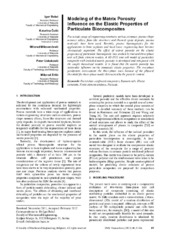Приказ основних података о документу
Modeling of the matrix porosity influence on the elastic properties of particulate biocomposites
Modeliranje uticaja matrične poroznosti na elastične osobine poroznih biokompozita
| dc.creator | Balać, Igor | |
| dc.creator | Čolić, Katarina | |
| dc.creator | Milovančević, Milorad | |
| dc.creator | Uskoković, Petar | |
| dc.creator | Zrilić, Milorad | |
| dc.date.accessioned | 2021-03-10T11:44:49Z | |
| dc.date.available | 2021-03-10T11:44:49Z | |
| dc.date.issued | 2012 | |
| dc.identifier.issn | 1451-2092 | |
| dc.identifier.uri | http://TechnoRep.tmf.bg.ac.rs/handle/123456789/2040 | |
| dc.description.abstract | For a wide range of engineering structures such as ceramics, porous shape memory alloys, foam-like structures and thermal spray deposits, porous materials have been used. Recently, porous biocomposites for the applications to bone implants and hard tissue engineering have become increasingly important. The effect of matrix porosity on the elastic properties of particulate biocomposite was studied by two-and three-phase unit cell finite element models. A 3D FCC unit cell model of particulate composite with included matrix porosity is developed and compared with the simple theoretical models. It is found that the matrix porosity has noticeable influence on the composite elastic properties. The two-phase predictions overestimate the three-phase ones because of the physical threshold for three-phase model determined by the particle content. | en |
| dc.description.abstract | Porozni materijali se koriste za široki spektar inženjerskih struktura napravljenih na bazi keramike, poroznih legura sa memorijskim efektom, penastih struktura, termički zaštitnih filmova. U skorije vreme primena poroznih biokompozita u inženjerstvu tvrdih tkiva kao i implanata kod koštanih defekata privlači posebnu pažnju. Uticaj matrične poroznosti na karakteristike elastičnosti čestičnih biokompozita analiziran je primenom metode konačnih elemenata upotrebom dvofaznog i trofaznog modela napravljenog na bazi reprezentativnog zapreminskog elementa - RZE. Razvijen je trofazni model RZE sa čestičnim ojačanjem raspoređenim u površinski centrirano kubnom rasporedu sa matričnom poroznošću oblika sfere, čiji su rezultati upoređeni sa jednostavnim analitičkom modelima. Primećeno je da matrična poroznost značajno utiče na karakteristike elastičnosti ovih vrsta kompozita. Rezultati dobijeni na osnovu dvofaznog modela imaju više vrednosti od onih dobijenih na osnovu trofaznog modela u skoro celom analiziranom opsegu usled fizičke granice za zapreminski udeo poroziteta kod trofaznog modela koja je očigledno određena vrednošću zapreminskog udela čestice ojačanja. | sr |
| dc.publisher | University of Belgrade - Faculty of Mechanical Engineering, Belgrade | |
| dc.relation | info:eu-repo/grantAgreement/MESTD/Integrated and Interdisciplinary Research (IIR or III)/45019/RS// | |
| dc.relation | EUREKA E!5851 | |
| dc.rights | openAccess | |
| dc.rights.uri | https://creativecommons.org/licenses/by/4.0/ | |
| dc.source | FME Transactions | |
| dc.subject | particulate reinforced composites | en |
| dc.subject | biomaterials | en |
| dc.subject | elastic constants | en |
| dc.subject | finite element analysis | en |
| dc.subject | porosity | en |
| dc.title | Modeling of the matrix porosity influence on the elastic properties of particulate biocomposites | en |
| dc.title | Modeliranje uticaja matrične poroznosti na elastične osobine poroznih biokompozita | sr |
| dc.type | article | |
| dc.rights.license | BY | |
| dc.citation.epage | 86 | |
| dc.citation.issue | 2 | |
| dc.citation.other | 40(2): 81-86 | |
| dc.citation.rank | M24 | |
| dc.citation.spage | 81 | |
| dc.citation.volume | 40 | |
| dc.identifier.fulltext | http://TechnoRep.tmf.bg.ac.rs/bitstream/id/15035/1451-20921202081B.pdf | |
| dc.identifier.rcub | https://hdl.handle.net/21.15107/rcub_technorep_2040 | |
| dc.identifier.scopus | 2-s2.0-84865567609 | |
| dc.type.version | publishedVersion |

